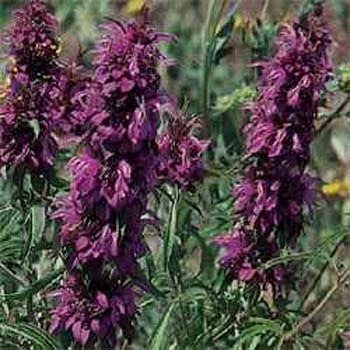New Account | Seed Mix |
Gift Certificates |AAS Winners |
Gardening Products
SEEDS: Unusual | Annuals | Perennials | Vegetables | Herbs | Trees
Bee Balm ( Monarda ) Seeds
It is deer resistant, easy to grow and will attract pollinators like bees, butterflies and hummingbirds to your garden. We have noticed that hummingbirds in particular seem to love this plant when in full bloom.
Pick bee balm flowers in summer as they appear. You can cut whole stems of bee balm to enjoy the flowers in a vase. Pick flowers for drying just before they open. You can also use fresh flowers as a garnish for green salads, fruit salads, cakes, or preserves. The aromatic leaves serve as a substitute for mint and can be dried for tea. Dried leaves and flowers are also useful in sachets and potpourri.
Useful gardening information
Monarda is hardy in USDA zones 4-9.Grows best in full sun but will tolerate light shade. Plants thrive in any moist soil that is rich in organic matter such as manure, compost, or leaf mold.
Fertilize in the spring with a good all purpose plant food.
Be sure to allow for good air circulation around plants to prevent attacks from powdery mildew which is a common ailment for this plant if packed in too tight with other plants.
You can stimulate a second flowering in the same year by cutting the flowers right after they finish blooming.
In the fall, prune the plants to within an inch of the ground. Plants should be divided every 3 years to keep them looking tidy. Dig up the root clump in the early spring, discard the older, inner portions, divide the remaining parts and re-plant the new divisions 12 to 15 inches apart.

2249 Bee Balm Panorama Mix ( Monarda didyma )
Popular, multi-purpose perennial. Semidouble blooms in shades of lavender, salmon, magenta, and pale to bright pinks are useful as cut and edible flowers. Additionally, Monarda attracts bees, butterflies, and hummingbirds to the garden.
Edible Flowers: Add petals to salads, sprinkle over mild fish, use in fruit salads, or to garnish desserts and drinks. Flavor is minty and spicy.Also known as beebalm, Oswego tea, and scarlet beebalm.
Medicinal: Aerial parts in infusions to improve digestion. Leaves and blooms contain thymol-related antibiotic-antiseptic compounds. Perennial in Zones 4-9. Ht. 36-44"
Edible Flowers: Add petals to salads, sprinkle over mild fish, use in fruit salads, or to garnish desserts and drinks. Flavor is minty and spicy.Also known as beebalm, Oswego tea, and scarlet beebalm.
Medicinal: Aerial parts in infusions to improve digestion. Leaves and blooms contain thymol-related antibiotic-antiseptic compounds. Perennial in Zones 4-9. Ht. 36-44"

2256 Wild Bergamot ( Monarda fistulosa )
Also known as Wild Bergamot this perennial is an upright growing plant which spreads out. It has a lovely lavender blossom and distinctively aromatic foliage. Its sweet nectar is a favorite of butterflies, bees and hummingbirds.
Sometimes called Mint Leaf Bee Balm, this native to eastern North America and the plains, and it is easy to grow from seeds and it multiplies quickly.
It can be found naturally along riverbanks and enjoys this rich, organic, moist soil. However, it will grow in average soil as well. Full sun is best, but light shade is tolerated. Plants tend to spread more quickly in the shade. Most Monarda herbs multiply rapidly either by underground stems or freely sowing their own flower seed. In order to keep plants healthy and vigorous, they should be divided at least every three years in the spring. Deadheading spent blooms will prolong the bloom time.
Sometimes called Mint Leaf Bee Balm, this native to eastern North America and the plains, and it is easy to grow from seeds and it multiplies quickly.
It can be found naturally along riverbanks and enjoys this rich, organic, moist soil. However, it will grow in average soil as well. Full sun is best, but light shade is tolerated. Plants tend to spread more quickly in the shade. Most Monarda herbs multiply rapidly either by underground stems or freely sowing their own flower seed. In order to keep plants healthy and vigorous, they should be divided at least every three years in the spring. Deadheading spent blooms will prolong the bloom time.

HR167 Lemon Mint ( Monarda citriodora )
A wonderful annual that attracts beneficial insects. Monarda Citriodora is commonly called Lemon Bee Balm, Lemon Mint, and Purple Horsemint. As the name suggests, it is an herb in the mint family. Lavender-to-pink, tuft-like, whorled flower heads attract hummingbirds, bees and butterflies. The Lemon Mint herb plant blooms from spring into late summer. Often late in the season the scent is described as resembling oregano more than lemon. Plants will grow about 36" tall.
Share a growing tip or recipe and help other gardeners!
Click on the Contact Form link, place "Tip" in the name line and fill in your information. If we accept your Bee Balm growing tip or recipe, we will post it on this page.
